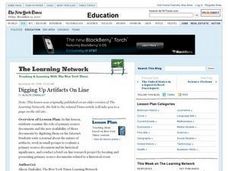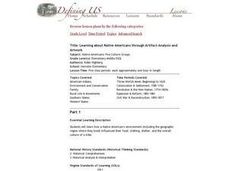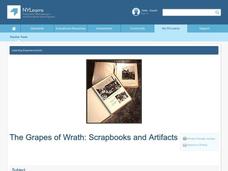Curated OER
Digging Up Artifacts On Line
Why is it important to preserve historical documents and artifacts? Examine the role of primary source documents and the availability of these documents on the Internet. Middle and high schoolers write a journal about the nature of...
University of Chicago
Using Artifacts for Clues About Identity
Learn about the ancient Near East through a close examination of ancient artifacts. Lead your class into analysis by first observing an artifact as a class. Pupils can then work in pairs to analyze the other artifacts and compile a list...
Curated OER
Primary Sources and Personal Artifacts
Connect historical text to primary sources. Researchers observe and discuss primary sources. Then, historians bring in their own personal artifacts and connect them back to their history.
Annenberg Foundation
Analyzing Artifacts
If only a mask could talk! Using the interactive tool along with historical thinking skills, pupils uncover the meaning behind the various materials the resource presents. History becomes more relevant as the artifacts tell their stories...
Curated OER
Dr. Dirt's Archaeology Lab Artifact Analysis
Students simulate analyzing artifacts in archaeological lab by using real techniques that archaeologists use. Students practice measuring skills, drawing, writing, and brainstorming, and make inferences based on evidence.
Curated OER
Artifact Analysis Worksheet
In this artifact analysis instructional activity, students decipher what type of artifact they have based on a complete list of criteria. Students then answer multiple questions based on their discoveries.
Curated OER
Learning about Native Americans through Artifact Analysis and Artwork
Sixth graders assess how a Native American's environment and the geographic region where they lived influenced their food, clothing, shelter and the overall culture of a tribe. They study the impact of conservation, family, rural life,...
Curated OER
Artifacts 1: What Can We Learn From Artifacts?
Sixth graders are introduced to artifacts and explore an online archaeological site to connect clues about how people once lived. For this deductive reasoning lesson, 6th graders participate in the stratigraphy game on Kids Dig Reed.com...
Code.org
Practice PT - Tell a Data Story
Show your class how it all comes together. The last lesson in a unit of 15 has individuals take everything they learned in the data section to analyze the class-generated data. The pupils find a story they want to tell that appeals to...
Chicago History Museum
Reading Artifacts
History detectives put their keen observation skills to the test as they closely examine artifacts. Drawing on visual and tactile clues, they formulate a theory about who done it, or in this case who made it, why, and for what purpose...
Museum of the American Revolution
Historical Analysis: Objects Tell Stories
Dig this! Young archeologists discover what objects teach us about the past. The activity uses an image of a Revolutionary War artifact to help historians practice analyzing the past. Scholars study the object and complete a worksheet to...
Curated OER
The Grapes of Wrath: Scrapbooks and Artifacts
Young scholars complete research to enhance their reading of "The Grapes of Wrath". Using the text, they identify and locate cultural artifacts and discuss their symbolic connotations. As a class, they create a museum exhibit of the...
Curated OER
Creating Historians Part Two: The Grab Bag
You don't need to be a museum curator to bring artifacts into the classroom; part two of a series on approaching social studies as a group of historians.
Calisphere
The 6 C's of Primary Source Analysis
Arm your class members with the six C's of primary source analysis—content, citation, context, connections, communication, and conclusions—and help them to establish a solid system for analyzing historical sources of information.
US House of Representatives
Objects in Time
What is the role artifacts play in the study of past events and people? As part of an examination of the careers and contributions of women in Congress from 1917 to 2006, groups examine artifacts that symbolize each woman.
Curated OER
What Do We Learn From the Repartiation of Alaska Native Artifacts?
Middle schoolers observe and evaluate evidence of Alaska Native cultural symbols and artifacts. They research historical data from a variety of primary resources, including the Harriman expedition journals, related web sites, oral...
Curated OER
Lesson: Snake Handling
Are the studies of art and archeology connected? You bet they are! Young scholars research the ancient temples of Mexico by visiting an archaeology site. They describe the various temples they see, taking note of shapes, stairs, details,...
Curated OER
Analyzing Artifacts Using Bloom's Taxonomy
Seventh graders apply Blooms Taxonomy to analyze a collection of artifacts. They define and discuss the nature of artifacts and work in groups to complete handouts. Students analyze an object (stone pipe) on a mystery artifact analysis...
Curated OER
Stones, Bones & Telephones: Analyzing Artifacts Using Bloom's Taxonomy
Seventh graders define metacognition, Bloom's Taxonomy, and artifacts. They, in groups, try to identify a mystery artifact using the Artifact Analysis sheet. They present their findings to the class.
Stanford University
Chronology: Civil Rights in the 20th Century
Test pupils' knowlege of history and the way civil rights movements unfolded using a series of images. With a primary source analysis activity, scholars practice their chronology and deductive reasoning skills. They use their knowledge...
Canadian Museum of Civilization Corporation
Artifacts Tell Stories: Creating a First World War Museum in the Classroom
Although designed for the Canadian War Museum, the concept here is a solid one. Class members select an artifact from the First World War, examine it, research it, and craft an explanative label that they attach to their picture and post...
Museum of the American Revolution
Object Observation: Purpose on a Powder Horn?
Young archeologists discover the significance of ordinary objects from the past in an interesting lesson on artifact analysis. The activity focuses on examining the image of a powder horn from the Revolutionary War to understand what it...
Curated OER
Daily Life in Spanish St. Augustine 1565-1763
How do we know so much about the past? A student-crafted presentation provides viewers with images of artifacts from St. Augustine, Florida that give historians and archaeologists clues into lives already lived.
Historica-Dominion Institute
Artifact Creation Activity
Creating an artifact that is representative of a specific time period provides an opportunity for amateur historians to understand the importance of primary sources. This resource describes the process for students to explore original or...

























